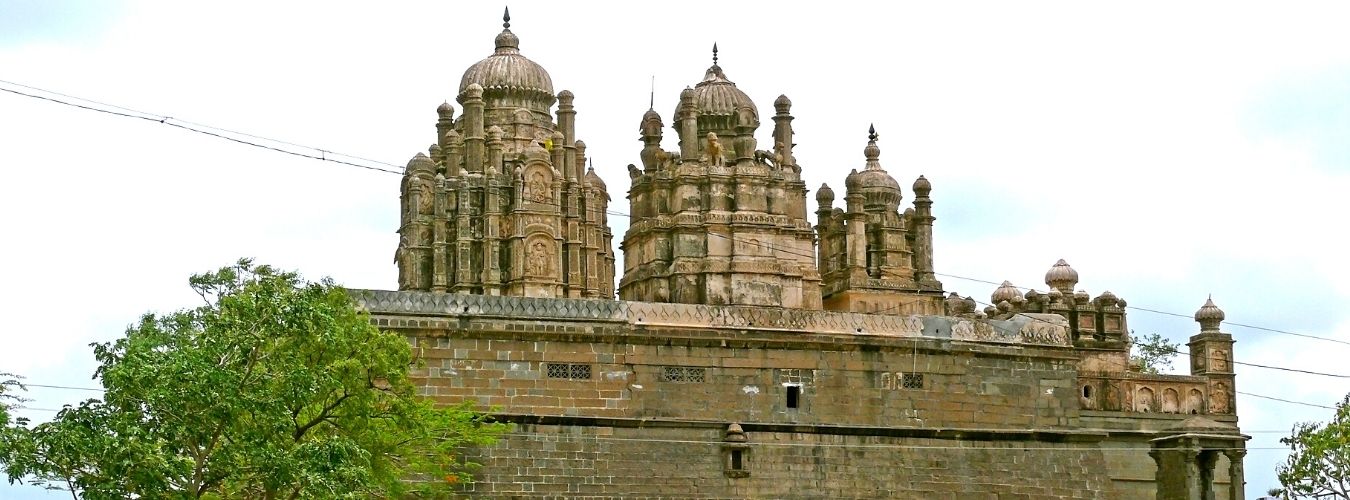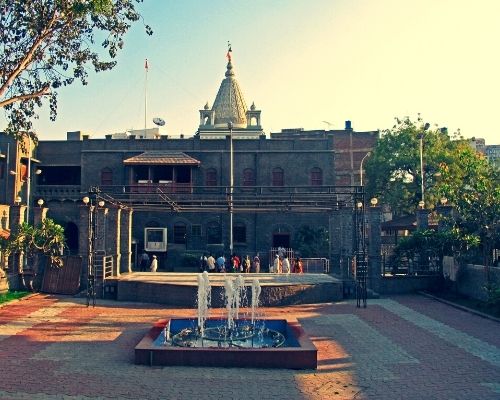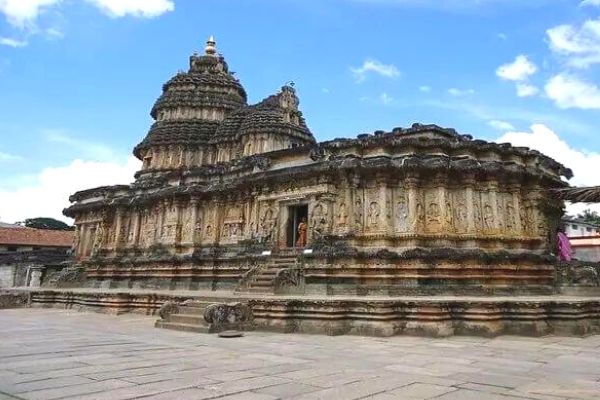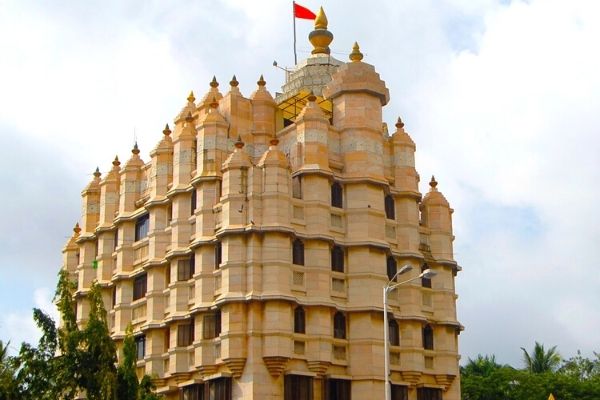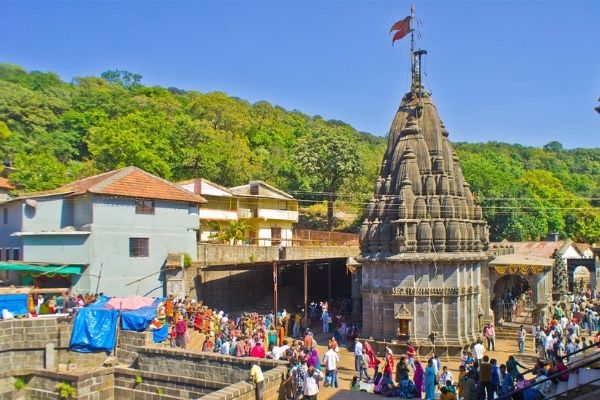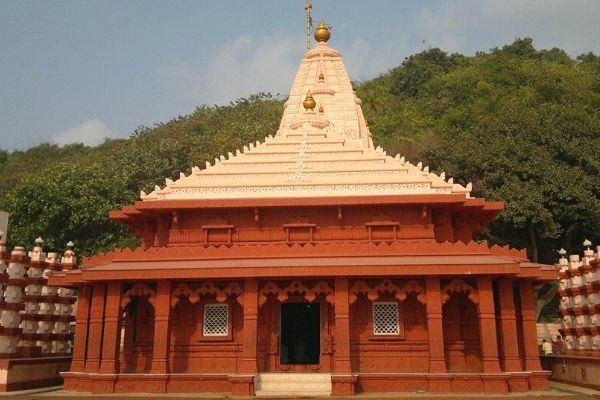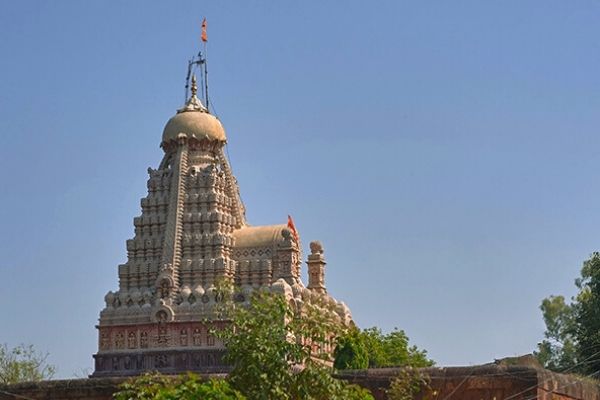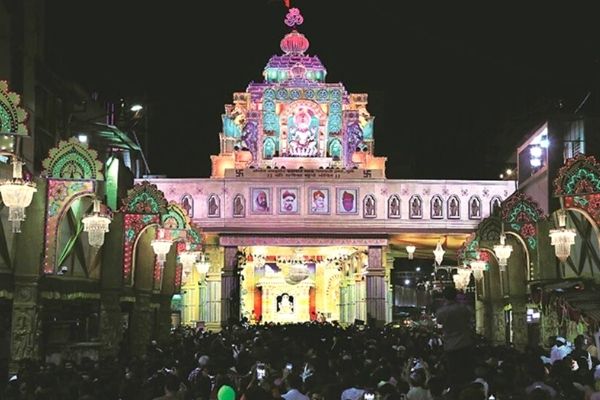Last Updated on September 20, 2025 by admin
Maharashtra is one of India’s fastest-growing states, with a metropolitan area and a number of cosmopolitan cities. Apart from the bustling cities, there are several opportunities to go throughout the city, which will undoubtedly make your vacation memorable. Maharashtra has something for everyone, from some of the best trekking trails to forts for history fans, wildlife sanctuaries for wildlife enthusiasts, and wineries for classy wine lovers. If you are interested in visiting Maharashtra’s pilgrimage sites, you will be shocked by the number of temples that exist in this state. A road trip to Maharashtra’s iconic temples would undoubtedly make your vacation worthwhile.
Top 10 Most Popular Temples in Maharashtra
In the list of the top-most popular temples in Maharashtra, you will find lots of varieties. Let us have a look at a few of the top points.
1. Shirdi Sai Baba Temple
Shirdi is a pilgrimage town in Maharashtra’s Ahmednagar district. It is 90 kilometres from Nashik, 180 kilometres from Pune, and 258 kilometres from Mumbai. As the most popular religious place, it is one of Maharashtra’s and India’s most popular pilgrimage destinations.
The shrine of Shirdi Sai Baba is the main attraction for devotees looking for places to visit near Mumbai. Sai Baba, who lived in the twentieth century, is considered one of India’s greatest saints. When Sai Baba was 16 years old, he came to Shirdi and stayed till his death in 1918. Sai Baba turned this little town into a hallowed pilgrimage spot for his disciples. This is a must-see attraction on Maharashtra tour packages.
Shirdi, one of the best pilgrimage destinations near Pune, is related to many stories of the famed Shirdi Sai. His selfless devotion and commitment to the needy earned him recognition, and he is still revered today. Shirdi is where he obtained his ‘Samadhi,’ or last resting place.
The Shirdi temple complex is around 200 square metres in size. Gurusthan, Samadhi Mandir, Dwarkamai, Chavadi, and Lendi Baug are all part of it. Shirdi Temple is one of India’s wealthiest temples, receiving an estimated INR 4 billion in annual donations. Other attractions in Shirdi include Maruti Temple, Khandoba Mandir, Sai Heritage Village, Shanisinghnapur, and Nashik.
Throughout the year, many followers of various faiths visit Shirdi Sai Baba’s shrine. Daily, 50,000 devotees travel to Shirdi village to see Sri Saibaba. Every day during the festival season, around 100,000 worshippers attend the shrine. The Sri Sai Baba Sansthan Trust (Shirdi) has offered 2,500 rooms with varying capacities. Apart from the temple trust complex, Shirdi provides a wide range of hotel alternatives, from affordable to five-star.
Shirdi Best Visiting Time:
Shirdi is best visited at any time of year; however, the peak season is from October to November.
Read About: Varanasi City: The City of Saints & Temples
2. Nashik Temples
Nashik, or Nasik, is a religious city located in the northwest region of Maharashtra, India. Nasik is the administrative headquarters of the Nashik district. It is 90 kilometres from Shirdi, 180 kilometres from Aurangabad, 182 kilometres from Mumbai, 211 kilometres from Pune, and 234 kilometres from Surat. Nashik is Maharashtra’s third-largest city by population and one of the state’s most popular pilgrimage destinations.
Nashik is a popular tourist destination near Aurangabad. Nasik, the Wine Capital of India, is located on the banks of the Godavari River at an elevation of 700 metres. Nashik is well-known for its numerous temples built during the reigns of various monarchs, which may be seen as part of Nashik vacation packages.
During their 14-year exile, Lord Rama, his wife Sita, and brother Lakshmana are said to have resided here for a time. The name Nashik is thought to stem from a Ramayana event in which Lakshmana chopped off Shurpanaka, Ravana’s sister’s Nasika (nose). Alternatively, the city has maintained a legacy of a Marathi adage stating that it was founded on nine summits.
Nashik has long been an important centre of commerce and trade in India. Nashik prospered during the Satavahana dynasty because it was on the trading route to Broach (Gujarat). In the 16th century, the city was renamed Gulshanabad and was ruled by the Mughals. It is also well-known for its role in India’s war for freedom. Famous freedom heroes like Veer Savarkar and Anant Laxman Kanhere were born here.
Some of the most popular Nashik attractions include Panchavati, Someshwar, Ram Kund, Muktidham Temple, Coin Museum, Pandavleni Caves, Sinnar, Anjaneri, and Trimbakeshwar. Apart from its religious significance, Nashik is recognised as India’s wine capital, with countless vineyards dotting the region.
Nashik Kumbh Mela
One of the most well-known events in Nasik is the Kumbha Mela, which happens every 12 years and is the biggest religious meeting in the world. The beautiful fair brings in a lot of visitors, sadhus, and holy men who bathe in the holy river Godavari. The Ramnavami Rath Yatra is another well-known event in Nashik. It is celebrated with a lot of show and circumstance.
The nearest airport is Mumbai Airport, which is around 167 kilometres from Nashik. Nashik Road Railway Station has rail connections to all of India’s main cities, including Mumbai, Delhi, Kolkata, Chennai, Hyderabad, and Bangalore. By bus, Nashik Central Bus Station in Thakkar Bazar is well connected to Indore, Pune, Aurangabad, Shirdi, Mumbai, Nanded, Nagpur, Akola, Hyderabad, Latur, Satara, Kolhapur, Ratnagiri, Ahmednagar, Ahmedabad, Solapur, Surat, Ahmadabad, Vadodara, and other cities.
Nashik is best visited from October to March, with November to February being the busiest season.
3. Siddhivinayak Temple in Mumbai
The deity of Ganesha is worshipped in Siddhivinayak Temple, one of Mumbai’s most famous Hindu sanctuaries. Initially constructed in 1801, the current building complex is the product of modifications performed in 1993. While the large amount of gold that covers the idol’s throne draws most tourists, there are various other aspects of this temple that draw them in.
On some days, as many as two lakh people are waiting in line to see Ganapati’s stone sculpture. So don’t be shocked if you see celebrities paying their respects at the shrine! (The Siddhivinayak Temple is a favourite destination for Bollywood actors seeking blessings before beginning a new production.) Even though this worship building is over 200 years old, repairs and active maintenance have kept it sparkling.
In Mumbai, Maharashtra, the Siddhivinayak Temple is located in Prabhadevi. It is a temple devoted to Lord Ganesha and is one of the country’s wealthiest temples. The shrine of Siddhivinayak is housed within a small mandap, with wooden sanctuary doors carved with Ashtavinayak images and a gold-plated inner ceiling. On the outside, the temple’s dome is wonderfully lit up with colourful lights every evening, and beneath it sits Lord Ganesha’s shrine. The temple is open every day of the week, and darshan is available from Wednesday through Monday at 05:30 am. Darshan times for the Siddhivinayak Temple are 03:15 a.m. to noon and 10:00 p.m. on Tuesday. Devotees can have free darshan, but VIP darshan tickets can be purchased at the temple desk.
You can also arrange a puja online through their official website. The Siddhivinayak Temple is roughly 11 kilometres from the Chhatrapati Shivaji International Airport, whereas the Dadar Railway Station is 2.5 kilometres away.
4. Bhimashankar Temple in Pune
Bhimshankar is a renowned pilgrimage place located in the ghat region of the Sahyadri hills in Maharashtra and is home to one of India’s 12 Jyotirlinga temples. According to Hindu mythology, Lord Shiva took the form of Bhima in the Sahyadri hills at the request of the gods to fight the demon Tripurasura. As a result, the area surrounding the Jyotirlinga became known as Bhimshankar. During Mahashivratri, a significant number of people flock to Bhimashankar.
Nana Fadnis, a Maratha statesman, was responsible for constructing the shrine. The temple, which dates from the 18th century, represents Nagra and Indo-Aryan architecture. Bhimashakar is a biodiversity hotspot as well as a pilgrimage site. The temple’s surroundings have been designated as a wildlife refuge. Leopards, barking deer, sambar, and hyenas can all be seen. The most famous resident is Shekru, or the giant Indian squirrel.
Bhimashankar is also well-known among adventurers. Trekking, hiking, and rock climbing are popular activities in Bhimashankar. Many adventurers flock to the jungles, especially during the monsoon season, to get their adrenaline fix.
5. Ganpatipule Temple
This is located 350 kilometres from Mumbai, in the Ratnagiri district of Maharashtra’s Kokan coast. ‘Ganpatipule’ is the home of Ganesha, a 400-year-old “Swayambhoo” (self-incarnated idol). Its origin can be deduced from allusions in ancient literature, such as the Mudgal-Puran, where it is known as the “Paschim Dwar-Devata” or “Paschim Dwarpalak” (Western Sentinel God).
There are several myths concerning temples and deities. For example, there used to be a ‘Kevada’ (flower tree) forest at the foot of the hill where the “Swayambhoo” Ganpati is now located 500 years ago, during the reigns of the Moguls. Balbhatji Bhide, a Brahmin, lived here.
He once faced a severe personal tragedy, but being a stubborn individual, he decided to forego food and water until his situation was resolved. As a result, he spent his penance and adoration of his tutelary deity, “Mangalmurti,” Lord Ganesha, in the Nevada forest.
During this time, Bhide had a dream in which Lord Ganesha told him that he had come to Aagargule (Ganesh Gule) in his “nirakar” (void) form to help all my believers. So, as a result, you worship and pray here.
One of Bhide’s cows was not producing milk during the same period, so the cowherd kept a close eye on her. He was astounded to see milk gushing from a cow’s udder on the spot where God’s idol is currently displayed.
The cowherd told Bhide about the occurrence, and when he cleaned up the area, he discovered the Ganesh statue he had seen in his vision. As a result, he constructed a shrine on a grassy knoll nearby and began performing his first rites.
6. Grishneshwar Temple
While no historical document establishes the temple’s exact construction date, it is widely assumed that it was built before the 13th century. The temple was repeatedly destroyed during the Delhi Sultanate’s 13th and 14th centuries of dominion. Grishneshwar Temple was renovated in the 16th century by Maloji Bhosale, Chhatrapati Shivaji Maharaj’s grandfather. Even after this, the temple was attacked. After the Mughal Empire fell, Rani Ahilyabai Holkar of Indore rebuilt the current temple edifice in the 18th century.
The Lord Shiva-dedicated Grishneshwar Temple is one of India’s holiest Hindu pilgrimage sites. Grishneshwar Temple is home to the world’s 12th and final Jyotirlinga, which is around 35 kilometres from Aurangabad and 2 kilometres from the UNESCO-listed Ellora Caves. It is an ancient sanctuary mentioned in the Shiva Purana, one of Hinduism’s sacred writings. The temple, said to have been established in the 13th century, was demolished and rebuilt several times throughout the rule of the Mughals until it was rebuilt in its current shape in the 18th century. The temple is now not only a religious place but also a significant tourist attraction in Maharashtra, particularly for visitors to the Ellora Caves.
Suppose you’re planning a trip to Aurangabad; set aside some time to visit this medieval temple. Everything you need to know about the Grishneshwar Temple, from its history to its hours and architecture to the entry charge, adjacent attractions, and lesser-known facts.
Read More: Kedarnath Jyotirlinga at Rudraprayag, Uttarakhand
7. Dagadusheth Halwai Ganapati Temple in Pune
When Shri Dagdusheth Halwai and his wife Lakshmibai lost their only son to the plague epidemic, they created the Lord Ganesha idol. After that, every year, not just Dagdusheth’s family but the entire neighbourhood celebrated the Ganpati holiday with solid faith and excitement. Tatyasaheb Godse, then a young man, was a lively participant in the festivities. Dagdusheth Ganpati became the most respected and beloved idol in Pune when Lokmanya Tilak made the Ganpati festival a public celebration to bring people together for the freedom movement.
Tatyasaheb and his group of companions were officially charged with planning the event at Dagdusheth Halwai Ganpati temple in 1952. Mamasaheb Rasane, Adv. Shankarrao Suryavanshi and K. D. Rasane, under Tatyasaheb’s skilled supervision and leadership, organised and executed the festival with thorough planning and professionalism, and they haven’t looked back since. As wealthy donors and devotees contributed to the temple fund, Tatyasaheb and his friends reasoned that there was no more fantastic way to adore the Lord than to assist our fellow humans.
Thanks to the hard work of a young, dedicated group, the festival and temple’s events soon went beyond traditional worship and into the areas of social and cultural growth. Along with their busy religious schedule at the temple, they took care of the state’s social and political problems.
They started several social initiatives under the Dagdusheth Halwai Sarvajanik Ganpati Trust, including educational and financial support for deprived children, micro-finance for small business people and vendors through Suvarnayug Sahakari Bank, a nursing home, and rehabilitation of brick kiln workers, to name a few.
8. Shani Shingnapur Temple in Ahmednagar
Shri Shaneshwar Devasthan, Shanishingnapur’s mythology is well-known as the shrine of many believers in Taluk Naivasha, District Ahmednagar. The number of astounding miracles recorded in The Guinness Book of World Records is impressive. Ahmednagar residents are regarded as the “Saints’ City.” God Shani is a scary entity in the minds of most Indians. However, it is useless for people to be afraid of God Shani. Why are you terrified of God Shani rather than the other Gods? Even though he is your friend rather than your adversary? Power and kindness play an essential role in our daily lives.
Shanishingnapur, the town with no doors, was founded by Shri Sahneshwar Devasthan. The Guinness Book of World Records has reported numerous miracles involving this creature. In terms of proof, what further is required? The sacred scriptures attracted many sceptics and devotees from other places of worship. The same thing was displayed to them. However, they were dissatisfied. The Hindi-speaking people of Maharashtra wanted holy scriptures in Hindi. Social, traditional, regional, national-unity, and religious aspects were all anticipated. They’d be dissatisfied almost immediately.
Finally, we sought the help of renowned writer and Principal Dr Bapu Rao Desai, who has been honoured by Maharashtra’s Hindi Sahitya Academy. He agreed to our request, translated the original content into Hindi, and formatted it beautifully. Finally, I want to thank him from the bottom of my heart.
9. Aundha Nagnath Temple in Hingoli
As an ancient temple of Lord Shiva in the Hingoli district, Aundha Nagnath Temple is one of the top Jyotirlingas. The temple campus is 60,000 square feet in size, with a temple that stands 60 feet tall and encompasses 7200 square feet. Apart from the sacred religious significance, there are many other things to see. The temple’s breathtakingly exquisite carvings are well worth seeing. The temple’s current building is of the Hemadpanti architectural style. A considerable number of pilgrims visit this site on the auspicious occasions of Vijayadashami and Maha Shivaratri.
The lives of saints such as Visoba Khechara, Namdev, and Jnanesvar are all linked to the shrine. Namdev went to Jnanesvar Temple and was told to go to Aundha Nagnath Temple to find a suitable guru. When Namdev discovered Visoba Khechara resting his feet on the lingam at the temple, he chastised him and warned him that he had offended Lord Shiva. Then Visoba told him to put his feet somewhere else, and a linga appeared wherever he put Visoba’s feet. He used his yogic powers to fill the entire temple with a Shiva lingam in this fashion. Namdev was also educated about God’s omnipresence by him.
Another well-known legend surrounds this temple. Namdev and his gurus were singing Bhajans in front of the temple when the temple priest urged them to stop since they were disrupting the regular worship. The priest insulted him (Namdev) because he belonged to a lower caste, and because of it, he had no permission to enter the temple. Namdev then returned to the temple’s backside and resumed singing the bhajans. Because God wanted to view the devotee and listen to the bhajans, he turned the entire temple around, which is why Nandi is always seen at the back of the temple.
Read More: Taxi in Bhubaneswar for Temple Tours
10. Ballaleshwar Ganpati Temple
On the Ashtvinayak tour, Shri Ballaleshwar Ashtvinayak Temple is one of Lord Ganesha’s eight temples. Among the Ashtavinayak Ganesha temples, Ballaleshwar Ganpati Temple is the only manifestation of Lord Ganesha recognised by his devotees’ name. Pali is a town/village located 57.1 km (by SH92) from Karjat in the Raigad district and 120 km from Pune. The Pali Ganesha temple is located in Maharashtra’s Raigad district, in the Konkan region. Between Fort Sarasgad and the Amba River, it is located.
In 1760, this wooden temple/mandir was repaired to make room for a new stone temple designed and constructed by ‘Shri Fadnis.’ It was shaped into the letter Shri during the development and construction phase by combining lead and cement. The east-facing temple was built such that the sun rays fall directly on the Lord Ganesha murti during worship when the sun rises. ‘Chimaji Appa’ (Peshwas) returned to the shrine after defeating the Portuguese in the wars of Vasai and Sasti.
The temple is completely tiled and is surrounded by two lakes. There are two sanatoriums in the temple: an inner and an outer sanctum. The outdoor sanctuary is only 12 feet (3.7 meters) tall, but the inner sanctum stands at 15 feet (4.6 meters). A rat-shaped murti faces Lord Ganesha in the outer shrine, grasping Modak (Sweet Prashad of Ganesha) in its hands. The beautiful main hall of the temple is 40 feet (12 meters) long and 20 feet (6.1 meters) wide, with eight pillars like Cyprus trees.
11. Vigneshwara Temple in Pune
Vigneshwara Temple, located on the banks of the Kukadi River, is one of Pune’s most well-known Hindu temples. Ganesha is popular as the Vigneshwara Temple. According to legend, Lord Ganesh made Ozar his permanent home after conquering the demon Vighnasur. As a result, the temple was given its name. The temple’s architecture is stunning, with a massive stone courtyard and walled passageways. There is a Ganesha deity in the seated position in the temple’s main sanctum. Between Bhadrapad, Tripuri Pournima, and Magh Chaturthi, when a fair is held, is the finest time to visit the temple.
One of the Ashtavinayaka is the Vigneshwara Temple. Vigneshwara Temple, located on the river Kukadi in Pune’s Junnar taluka, was previously Lord Ganesha’s permanent residence. The historical significance of this location can be traced back to the narrative of a monarch named Abhinandan.

